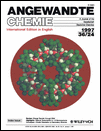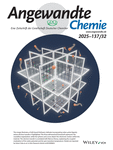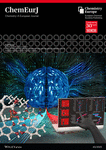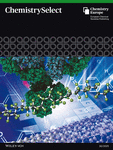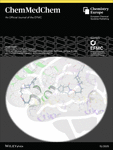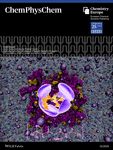Journal list menu
Export Citations
Download PDFs
Cover Picture (Angew. Chem. Int. Ed. Engl. 24/1997)
- First Published: January 7, 1997

The cover picture might resemble a Christmas decoration, as one can expect at this time of the year, but is in fact a space-filling model of the structure of an octadecairon(III) complex that shows idealized D3d symmetry. Cyclic molecules have always fascinated chemists—see for example the Highlight on p. 348 in issue 4 of this year—and there are many molecular counterparts of everyday ring-shaped objects. Multinuclear macrocyclic transition metal complexes can have interesting characteristics. Antiferromagnetic interactions occur between the 18 high-spin iron(III) centers in the molecular 18-wheeler shown in the cover picture. More on the largest known ring-shaped iron(III) compound is reported by S. J. Lippard et al. on p. 2774 ff (computer graphics: Felice Frankel, Massachusetts Institute of Technology).
Graphical Abstract (Angew. Chem. Int. Ed. Engl. 24/1997)
- Pages: 2701-2711
- First Published: January 7, 1997
Corrigenda
Reviews
Charge Transfer through the DNA Base Stack
- Pages: 2714-2730
- First Published: January 7, 1997

Electron transfer between intercalators bound to DNA are remarkably efficient and point to the double helix as a unique matrix which facilitates chemistry from a distance. When the stacked DNA bases not only mediate electron transfer but also serve as reactants, selective oxidative damage at guanine bases (see below) and repair of lesions in thymine dimers may be promoted from a remote site.
Highlights
Nonenzymatic Kinetic Resolution of Secondary Alcohols
- Pages: 2731-2733
- First Published: January 7, 1997
Valence Tautomeric Interconversion in Transition Metal 1,2-Benzoquinone Complexes
- Pages: 2734-2736
- First Published: January 7, 1997
For the development of molecule-based switching devices, cobalt and manganese complexes of 1,2-benzoquinone ligands are of great interest. These compounds have electronically labile ground states, which leads to phenomena such as mixed valency, spin crossover, and valence tautomerism. Recently, the electronic behavior of these complexes was investigated carefully, and there are indications that complexes that show such characteristics can also be obtained with other metals.
Communications
Enantioselective Synthesis of Altohyrtin C (Spongistatin 2): Synthesis of the AB- and CD-Spiroketal Subunits†‡
- Pages: 2738-2741
- First Published: January 7, 1997

The first total synthesis of a spongipyran macrolide, altohyrtin C (spongistatin 2; see picture below), has been realized. The spongipyrans derived from marine sponges are among the most potent cytotoxic compounds yet isolated, and exhibit subnanomolar activities against a variety of human cancer cell lines. While the structures proposed for the independently isolated altohyrtins and spongistatins are largely homologous, they differ significantly with regard to internal stereochemical relationships. This discrepancy has been resolved by the total synthesis, which verifies the altohyrtin structural assignment and establishes the identity of altohyrtin C and the independently isolated spongistatin 2.
Enantioselective Synthesis of Altohyrtin C (Spongistatin 2): Synthesis of the EF-Bis(pyran) Subunit†‡
- Pages: 2741-2744
- First Published: January 7, 1997
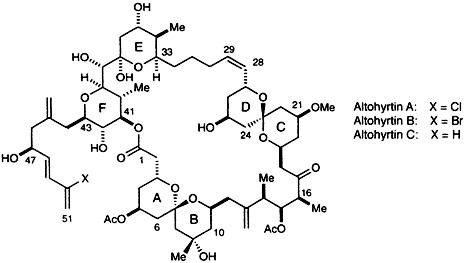
The first total synthesis of a spongipyran macrolide, altohyrtin C (spongistatin 2; see picture below), has been realized. The spongipyrans derived from marine sponges are among the most potent cytotoxic compounds yet isolated, and exhibit subnanomolar activities against a variety of human cancer cell lines. While the structures proposed for the independently isolated altohyrtins and spongistatins are largely homologous, they differ significantly with regard to internal stereochemical relationships. This discrepancy has been resolved by the total synthesis, which verifies the altohyrtin structural assignment and establishes the identity of altohyrtin C and the independently isolated spongistatin 2.
Enantioselective Synthesis of Altohyrtin C (Spongistatin 2): Fragment Assembly and Revision of the Spongistatin 2 Stereochemical Assignment†‡
- Pages: 2744-2747
- First Published: January 7, 1997

The first total synthesis of a spongipyran macrolide, altohyrtin C (spongistatin 2; see picture below), has been realized. The spongipyrans derived from marine sponges are among the most potent cytotoxic compounds yet isolated, and exhibit subnanomolar activities against a variety of human cancer cell lines. While the structures proposed for the independently isolated altohyrtins and spongistatins are largely homologous, they differ significantly with regard to internal stereochemical relationships. This discrepancy has been resolved by the total synthesis, which verifies the altohyrtin structural assignment and establishes the identity of altohyrtin C and the independently isolated spongistatin 2.
Artificial Anthraquinone–Carbohydrate Hybrids: Design, Synthesis, DNA Binding, and Cytotoxicity†
- Pages: 2748-2750
- First Published: January 7, 1997

Intercalation and sequence selectivity characterize the binding of the anthraquinone–carbohydrate hydrid 1 to DNA. Important for this binding and for the cytotoxicity of 1 is the hybrid structure, which is based on that of several natural antitumor antibiotics. The enantiomer of 1 is about six times less cytotoxic because of its distinctly reduced intercalation potential.
Synthesis of Optically Active Butenolides and γ-Lactones by the Sharpless Asymmetric Dihydroxylation of β,γ-Unsaturated Carboxylic Esters†
- Pages: 2750-2752
- First Published: January 7, 1997

Deconjugated esters 1 and AD mix α or AD mix β give cis-configured γ-alkyl-β-hydroxy-γ-lactones 2. They are versatile precursors for γ-chiral butenolides and γ-chiral butyrolactones of moderate to high enantiomeric purity, as shown through their conversion into the natural products 3 (92% ee), 4 (95% ee), 5 (97% ee), and 6 (78% ee).
A Hexaimidazole Ligand Binding Six Octahedral Metal Ions To Give an Infinite 3D α-Po-Like Network Through Which Two Independent 2D Hydrogen-Bonded Networks Interweave†
- Pages: 2752-2755
- First Published: January 7, 1997

The new ligand hexakis(imidazol-1-ylmethyl)benzene (hkimb, 1) forms a heavily hydrated coordination polymer with CdF2 of composition Cd(hkimb)F2 · 14 H2O. A unique aspect of the structure is that the water assembles itself into two independent and different hydrogen-bonded 2D networks, which interweave throughout the 3D α-Po-related coordination polymer network.
Periodic Structure of a Single Sheet of a Clothlike Macromolecule (Atomic Cloth) Studied by Scanning Tunneling Microscopy†
- Pages: 2755-2757
- First Published: January 7, 1997

Fused parallelogrammic rings sharing all sides are seen in the structure of 1 (shown below). This atomic cloth was prepared by photopolymerizing alkatetryne molecules that were vapor-deposited and laid flat on graphite. The structural fit between the atomic cloth and the substrate, observed by scanning tunneling microscopy, enables one to determine the unit mesh.
Conformation Control in Polymetallic Mesocycles by Metal–Metal Bonding: The First Example of an HgCu Interaction†‡
- Pages: 2758-2761
- First Published: January 7, 1997

A ten-membered heterometallic ring complex with a T-shaped CuHgFe2 framework is the result of a bonding CuHg interaction (CuHg 2.668(6) Å). In solution this complex exhibits a motion comparable to a “molecular torsion pendulum” (shown schematically below), which generates an average mirror plane containing the four metal atoms; in the solid state only a C2 axis is present.
Theoretical Studies of the Structure, Aromaticity, and Magnetic Properties of o-Benzyne†‡
- Pages: 2761-2764
- First Published: January 7, 1997
Theoretical computations give new insights into the energetic, geometric, and magnetic properties of highly reactive o-benzyne. Comparisons with experimental NMR data for the species trapped in a hemicarcerand agree best for the geometry optimized at the Becke3LYP/6-311 + G** density functional level, which has more acetylenic (cyclohexa-3,5-dienyne) than cumulenic character.
Merocyanine Dyes in the Cyanine Limit: A New Class of Chromophores for Photorefractive Materials†
- Pages: 2765-2768
- First Published: January 7, 1997

By tuning the donor–acceptor strength in heterocyclic methine dyes such as 1, the cyanine limit was accessible. Despite almost vanishing second-order polarizabilities (β) this new class of chromophores sets a new hallmark for photorefractive applications. With a dye content of only 20% complete diffraction of the readout beam is achieved at a wave-length of 790 nm and a field strength of 68 V μm−1.
Self-Assembly of Several Components into a Highly Enantioselective Ti Catalyst for Carbonyl-Ene Reactions†‡
- Pages: 2768-2771
- First Published: January 7, 1997

“Smart” self-assembly of several chiral diols and an achiral pre-catalyst results in the formation of a highly enantioselective catalyst for the carbonyl–ene reaction (a). The assembly is not influenced by the order of addition of the components and always results in the exclusive formation of a single catalyst, as shown by NMR spectroscopy studies.
Noncovalent Interactions in Organometallic Compounds: Formation of an Intramolecular Metal–Carbon Ion Pair in Zirconium Borate Betaines†
- Pages: 2771-2774
- First Published: January 7, 1997
A Cyclic Octadecairon(III) Complex, the Molecular 18-Wheeler†
- Pages: 2774-2776
- First Published: January 7, 1997
Scission of DNA with Bis(1,10-phenanthroline)copper without Intramolecular Hydrogen Migration†
- Pages: 2776-2778
- First Published: January 7, 1997

C-1′H and not C-2′H is the initial site of oxidative cleavage of DNA with the chemical nuclease [Cu(phen)2]+/H2O2. This is the result of experiments with DNA containing C-1′-deuterated thymidine groups (the first step of the reaction sequence is shown below). If C-2′H is extracted in the first step, a one-electron oxidation and H/D migration should take place; there is no evidence of this.
Rhenium Complexes with a Photochemically Variable Anthracene Subunit: A Molecular Switch†
- Pages: 2779-2781
- First Published: January 7, 1997

A markedly different emission behavior is exhibited by the two rhenium complexes 1 and 2. These can be interconverted photochemically; the forward reaction (cyclization to the “closed” form) is triggered by visible light, and the reverse reaction by UV light. Therefore, this is a photoswitchable molecular system in which the anthracene groups function as the switching unit and the complexed rhenium as the detector.
A Highly Enantiomerically Enriched α-Thiobenzyl Derivative with Unusual Configurational Stability†‡
- Pages: 2784-2786
- First Published: January 7, 1997
A Highly Stable Silver(I) Complex of a Macrocycle Derived from Tetraazatetrathiacyclen†
- Pages: 2786-2788
- First Published: January 7, 1997

The highest known binding constant for the silver(I) complex with a cyclen-derived ligand was recently measured (lg K = 19.63; crystal structure shown on the right). This ligand is preorganized in the metal-free form. It contains four nitrogen and four sulfur atoms, but the soft silver(I) ion prefers coordination through the nitrogen atoms and binds to only two sulfur atoms in the solid state. The chelating ligand was designed for in vivo therapeutic application of the β-emitting radio-nuclide IIIAg.
A New Technique for Assembling Thin, Defined Multilayers†
- Pages: 2788-2791
- First Published: January 7, 1997
Interchangeable Coordination Geometries: pH-Controlled Change of Trigonal-Prismatic to Octahedral Metal Coordination in a Dinuclear Cobalt(II) Complex†
- Pages: 2791-2793
- First Published: January 7, 1997
From D-Glucose to a New Chiral Cyclooctenone†
- Pages: 2793-2794
- First Published: January 7, 1997
Synthesis of an ABC Ring Analogue of Kapurimycin A3 as an Effective DNA Alkylating Agent†
- Pages: 2794-2797
- First Published: January 7, 1997

With a 5′-GPu-3′ sequence selectivity that is very similar to that of the natural antitumor antibiotic kapurimycin A3 (1), the ABC ring analogue 2 effectively cleaves DNA by guanine alkylation. Essential for cleavage activity are the reactive alkenyl epoxide group in the side chain and the strong intercalation of the aromatic units of 1 and 2 in the DNA duplex; this was made clear by the significantly lower activity of an AB ring analogue.
Synthesis and Crystal Structure of [Cd10Se4(SePh)12(PPh3)4] and [Cd16(SePh)32(PPh3)2]†
- Pages: 2797-2799
- First Published: January 7, 1997
![Synthesis and Crystal Structure of [Cd10Se4(SePh)12(PPh3)4] and [Cd16(SePh)32(PPh3)2]](/cms/asset/b73c2e5f-30e6-4ba9-b817-009c4052e9dd/must001.jpg)
Clusters with and without cavities are formed in the reaction of [CdCl2(PPh3)2] with PhSeSiMe3. Depending on the organic solvent used, [Cd10Se4(SePh)12(PPh3)4] or [Cd16(SePh)32(PPh3)2] (depicted on the right; the cluster is almost completely covered with phenyl rings) crystallizes. The clusters are composed of fused adamantanoid CdSe cages.
Structural Evolution from the Solid State to the Molecule for BaI2: Synthesis and Crystal Structures of [BaI2(μ2-OH2)2]3/∞, [BaI2(μ2-OH2)(OC3H6)]2/∞, [BaI2(thf)3]1/∞, and [BaI2(thf)5] · THF†
- Pages: 2799-2801
- First Published: January 7, 1997
The use of different donor ligands as chemical scissors allows fragments to be “cut out” from the solid-state structure of BaI2, which results in the barium compounds given in the title. According to X-ray structural analyses these compounds exhibit different dimensionalities.
Rate Enhancement of the Pauson–Khand Reaction by Primary Amines†
- Pages: 2801-2804
- First Published: January 7, 1997

Two economical and practical sets of conditions have been developed for the Pauson–Khand reaction on the basis that primary amines accelerate this reaction. One method employs more than three equivalents of cyclohexylamine in 1,2-dichloroethane at 83°C, whereas the other requires a mixed solvent of 1,4-dioxane and 2 m aqueous NH3 (1/3 v/v) at 100°C. Under these conditions, for instance, the cylization shown below is complete in 5 or 15 minutes, respectively, and the product is isolated in 99 or 93% yield, respectively.
Stepwise Reaction of Bis(iodozincio)methane with Two Different Electrophiles†
- Pages: 2804-2805
- First Published: January 7, 1997
[Pd2(dba)3] in the presence of trifurylphosphane catalyzes the stepwise reaction of CH2(ZnI)2 with different electrophiles [Eq. (a)]. The homologous Zn2 compound CH3CH(ZnI)2 reacts in the first step analogously with cinnamyl chloride; however, stoichiometric amounts of CuCN/LiCN are required for the coupling with allyl bromide in the second step
Trisannelated Benzenes by Cyclotrimerization of Bromostannylalkenes†
- Pages: 2805-2807
- First Published: January 7, 1997

Up to 80% yields of cyclotrimers, including 2 depicted below, can be achieved by reaction of bromo(stannyl)alkenes such as 1 with Cu(NO3)2 · 3H2O at room temperature in THF. This route, a definite improvement over previously reported methods, makes such molecules available in sufficient quantity for study, for example, as precursors of fullerene fragments.
β-Donor Bonds in Compounds Containing SiON Fragments†‡
- Pages: 2807-2809
- First Published: January 7, 1997

Strongly compressed Si-O-N angles are observed in H3SiONMe2 (crystal structure shown on the right) and H2Si(ONMe2)2 with respect to the Si-O-C angle in isoelectronic SiOC compounds. This is due to weak donor–acceptor bonds between the Si and N atoms. The resulting partial hypercoordination at silicon explains the unique chemical behavior of hydroxylaminosilanes.
PHONA – PNA Co-Oligomers: Nucleic Acid Mimetics with Interesting Properties
- Pages: 2809-2812
- First Published: January 7, 1997
Cylindrical Molecular Brushes†
- Pages: 2812-2815
- First Published: January 7, 1997

A two-dimensional labyrinth is formed by self-organization of cyclindrical brushlike polymacromonomers. Single “brush molecules” can be visualized by atomic force microscopy within a monolayer (see picture on the right). This represents a first step towards the production of well-defined nanostructured surfaces with molecular resolution.
The First Structurally Authenticated σ-Bonded Organosamarium(II) Derivative and Its Reaction with Benzophenone
- Pages: 2815-2817
- First Published: January 7, 1997

The first SmIIC σ bonds to be verified by X-ray structure analysis are 2.787(5) and 2.845(5) Å in length. These distances were obtained for a samarium(II) complex in which two C(SiMe3)2(SiMe2 OMe) ligands are each bound to the samarium center through the carbanionic carbon center and the oxygen atom of the methoxy group (see structure depicted on the right). This compound reacts with benzophenone to give the corresponding samarium(III) ketal radical anion complex.
Stuctural Reorganization of Anthracene-Bridged Stilbenoids by Oxidation and Reduction†
- Pages: 2817-2819
- First Published: January 7, 1997
Complexes with Sb2 and cyclo-Sb3 Ligands: The Tetrahedranes [{C5H5(CO)2Mo}2Sb2], [C5H5(CO)2MoSb3], and [C5Me5(CO)2MoSb3]†‡
- Pages: 2819-2821
- First Published: January 7, 1997
![Complexes with Sb2 and cyclo-Sb3 Ligands: The Tetrahedranes [{C5H5(CO)2Mo}2Sb2], [C5H5(CO)2MoSb3], and [C5Me5(CO)2MoSb3]](/cms/asset/66b79331-b09d-4418-954b-1dc8f7736a0d/must001.jpg)
A suitable antimony source for complexes with substituent-free Sbn ligands is the four-membered ring (tBuSb)4, which reacts with [{C5H5(CO)3Mo}2] to yield the tetrahedranes 1 and 2, and with [{C5Me5(CO)3Mo}2] to give 3. Compounds 2 and 3 are the first complexes to contain the cyclo-Sb3 ligand. In the crystal they are linked through close SbSb interactions.
A Novel Approach to the CP-225,917 and CP-263,114 Core†
- Pages: 2821-2823
- First Published: January 7, 1997

A Rh-catalyzed generation of a carbenoid and its intramolecular trapping, followed by a divinylcyclopropane rearrangement and a radical cyclization, are the crucial reactions in a new strategy for constructing the bicyclo[4.3.1]dec-1(9),4-diene-10-one framework of the natural products in the title. The resulting model compound 1 differs from this target core only in the configuration of the quaternary center.
Five-Coordinate Silicon in Zeolites: Probing SiO4/2F− Sites in Nonasil and ZSM-5 with 29Si Solid-State NMR Spectroscopy†
- Pages: 2823-2825
- First Published: January 7, 1997

With fluoride as a mineralizing agent, the high-silica zeolites nonasil and ZSM-5 were obtained by hydrothermal syntheses. 29Si NMR spectroscopy showed that five-coordinate silicon exists in the form of SiO4/2F− in the zeolite frameworks (see the 29Si{19F} CPMAS NMR spectrum of nonasil on the right). In ZSM-5 at room temperature the fluoride ion undergoes a dynamic exchange between different silicon atoms, which is frozen out at 140 K.
Highly Precise Shape Mimicry by a Difluorotoluene Deoxynucleoside, a Replication-Competent Substitute for Thymidine†
- Pages: 2825-2828
- First Published: January 7, 1997

Large differences in the electrostatic properties of nucleosides can have surprisingly small effects on DNA replication. Size and shape appear to be more important, as structural studies of difluorotoluene deoxynucleoside 1, an isostere of thymidine (2), prove. The two nucleosides have virtually the same aromatic ring, almost identical sugar puckers, and very similar glycosidic angles (see the structural formulas). Hydrogen-bonding capacity is apparently not crucial for templating in DNA replication.
[2+1] Cycloadditions of Diazoalkanes to Enol Ethers Catalyzed by Chromium Complexes—The First Direct Spectroscopic Observation of a Carbene Complex Intermediate†‡
- Pages: 2828-2830
- First Published: January 7, 1997
![[2+1] Cycloadditions of Diazoalkanes to Enol Ethers Catalyzed by Chromium Complexes—The First Direct Spectroscopic Observation of a Carbene Complex Intermediate](/cms/asset/6d938942-77f1-4196-af44-50ffe926f15e/must001.jpg)
A new catalytic route to cyclopropanes from alkenes and diazolakanes is provided by pentacarbonyl(η2-cis-cyclooctene)chromium(0), which generates the catalyst “Cr(CO)5”. The reactions (1) are characterized by a pronounced chemoselectivity of the participating carbene complex intermediates 1 and allow the unambiguous discrimination of diversely substituted olefins.
Creation of Enantioselective Biocatalysts for Organic Chemistry by In Vitro Evolution
- Pages: 2830-2832
- First Published: January 7, 1997

Evolution in the test tube: With the help of the error-prone polymerase chain reaction as a method for random mutagenesis, an efficient gene-expression system, and a screening test for the rapid identification of enantioselective catalysts, it is possible to increase sequentially the ee value of an unselective lipase-catalyzed ester hydrolysis (see picture on the right).
Shape-Selective Hydrogenation and Oxidation over a Platinum-Containing Ultramicroporous Heteropolyoxometallic Compound†
- Pages: 2833-2835
- First Published: January 7, 1997

Preferentially smaller molecules are oxidized and hydrogenated in the presence of the ultramicroporous (pore diameter < 5.9 Å), platinum-containing (0.5 wt%) heteropolyoxometalate compound Pt/Cs2.1H0.9PW12O40, according to studies with methane/2,2-dimethylpropane and ethene/cyclohexene (shown schematically on the right).
Stabilization of Atomic Nitrogen Inside C60†
- Pages: 2835-2838
- First Published: January 7, 1997

The concave inner face of C60 is so inert with respect to the formation of covalent bonds, that even atomic nitrogen in the quartet ground state is stable as an encapsulated guest (shown on the right). Semiempirical calculations and ESR investigations offer an explanation for this unprecedented behavior.




